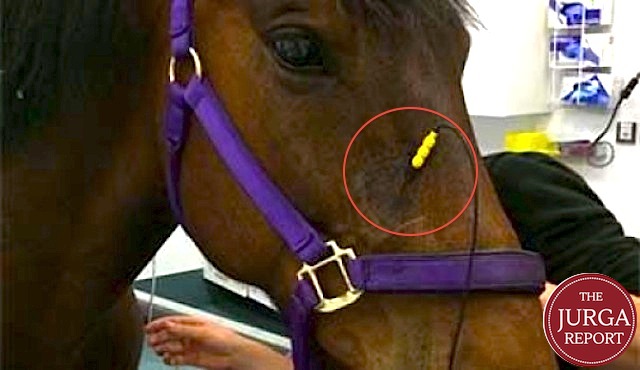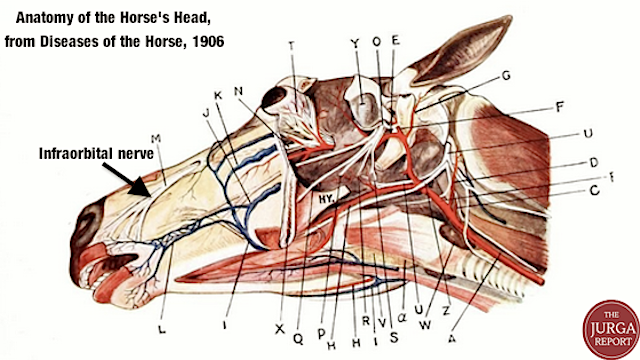Research: Headshaking in Horses Helped with Nerve Stimulation
- March 10, 2017
- ⎯ Fran Jurga

The University of Bristol in Great Britain is sharing information about a new treatment for headshaking in horses. Some horses are fortunate to find relief in a simple nose net; an estimated one-third of headshaking horses show improvement up to 70 percent with the nets. Researchers are handicapped by the fact that the condition is not fully understood; the University of Bristol researchers describe it as a “neuropathic facial pain syndrome”.
In 2012, The Jurga Report gave details of research at the University of Bristol that tested surgical compression of the infraorbital nerve for treatment of the problem. Two years later, the veterinary researchers have collaborated with human neurology specialists to suggest a less invasive treatment.

The new study utilizes percutaneous electrical nerve stimulation (PENS) of the nerve to reduce signs of the condition in horses. The same PENS therapy is used in people to manage neuropathic pain, and involves inserting a sensor under the skin and stimulating the nerve.
Headshaking affects horses differently but some horses are so severely affected that they are impossible to ride and dangerous to handle; headshaking can result in euthanasia. In spite of this and other research, it’s important to remember that there is still no “cure” for headshaking. This treatment is designed to lessen the symptoms.
The research is detailed in a paper published in the Equine Veterinary Journal.

The University of Bristol shares with us:
Headshaking syndrome, which is thought to affect between 10,000 and 20,000 horses in the UK, is when a horse shakes or jerks its head uncontrollably for no apparent reason. There are striking clinical similarities between facial pain syndromes in people, most notably trigeminal neuralgia.
For this study, clinical academics from the University of Bristol’s School of Veterinary Sciences, working with the neurology team at Southmead Hospital Bristol. Their aim was to find out if PENS therapy, developed by Algotec Research and Development Ltd, is safe, effective and sustainable for the management of trigeminal-mediated headshaking in horses.
Seven horses diagnosed with trigeminal-mediated headshaking were recruited to the trial. All procedures were carried out in sedated horses with a needle-prick sized area of skin desensitized with local anesthetic to help probe insertion. A disposable PENS probe was placed just beneath the skin adjacent to the nerve under ultrasonographic guidance.
The nerve was stimulated for 25 minutes following a protocol of alternating frequencies and a perception threshold based on human clinical data. The probe was removed and the procedure repeated on the other side of the horse’s face. Three or four treatments were used during the protocol, with treatments being repeated when signs of headshaking recurred.
All horses tolerated the procedure well. Three horses developed a hematoma at the site on one occasion and two had increased clinical signs for up to three days following the first treatment.
Six horses responded well after the first treatment and returned to ridden work at the same level before headshaking began. Five horses continued to respond to further treatment.
Veronica Roberts, Senior Clinical Fellow in Equine Medicine in the University’s School of Veterinary Sciences, led the study. She said: “Headshaking in horses is a major welfare issue and can be a significant cause of distress.
“Although it is clear that further work is required, including increasing the number of cases and refining the treatment procedures, the study shows that PENS therapy should be the first-line treatment for trigeminal-mediated headshakers, which have failed to respond to conservative treatment, such as nose-nets.”
Link to research paper:
‘Neuromodulation using percutaneous electrical nerve stimulation for the management of trigeminal-mediated headshaking; a safe procedure resulting in medium term remission in five of seven horses’ by Roberts V L, Patel N K, Tremaine W H published online in Equine Veterinary Journal.
Further information
The researchers would like to acknowledge the Langford Trust for Animal Health and Welfare for funding the study and Algotec Research and Development Ltd.
Headshaker Horses, Head Here for Resources and Research (The Jurga Report archives)
Headshaking: British Researchers Tout Success of Surgical Compression of Infraorbital Nerve; Parallel Found to Trigeminal Neuralgia in Humans (The Jurga Report archives)





